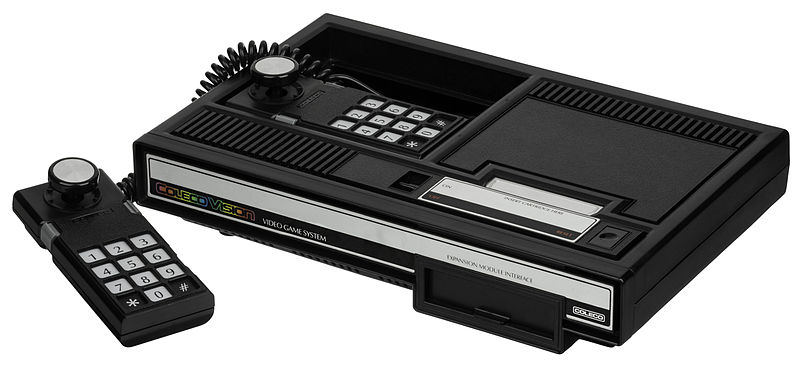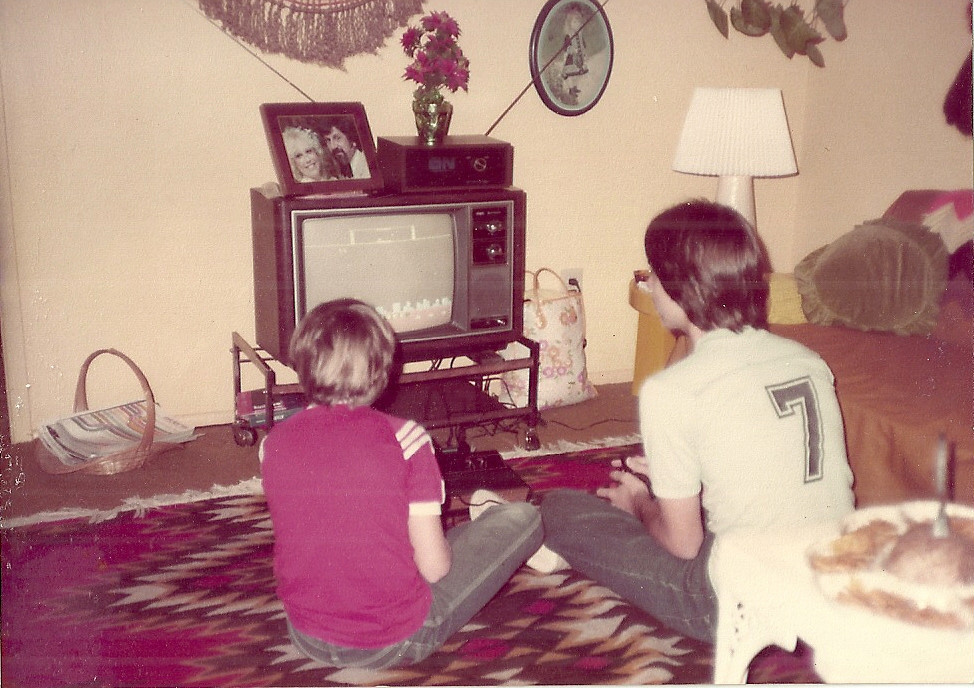
Console Living Room
The home console market is credited with slowly shifting attention from the arcade craze of the early 1980s and causing arcades to shrink in popularity, leaving a small percentage of what once were many.
Through use of the JSMESS emulator system, which allows direct access to these programs in your browser with no additional plugins or settings, these games can be enjoyed again. Simply click on the screenshot or "Emulate This" button for each individual cartridge, and on modern browsers the games will just start to run. As nostalgia, a teaching tool, or just plain fun, you'll find hundreds of the games that started a billion-dollar industry.
These games are best enjoyed in an up to date version of a modern browser. Currently, there is no sound in the games, although that feature will be added soon. Please read carefully regarding key mappings of the games and programs, to use them in your browser.
Simply click on a system below to browse through available games and cartridges and try them out. Where possible, links to manuals and additional information are available for reference.

| The Atari 2600 a video game console released in September 1977 by Atari, Inc. It is credited with popularizing the use of microprocessor-based hardware and ROM cartridges containing game code, a format first used with the Fairchild Channel F, instead of having non-microprocessor dedicated hardware with all games built in. The console was originally sold as the Atari VCS, for Video Computer System. Following the release of the Atari 5200, in 1982, the VCS was renamed "Atari 2600", after the unit's Atari part number, CX2600. The 2600 was typically bundled with two joystick controllers, a conjoined pair of paddle controllers, and a cartridge game—initially Combat and later Pac-Man. The Atari 2600 was wildly successful, and during much of the 1980s, "Atari" was a synonym for this model in mainstream media and, by extension, for video games in general. The Atari 2600 was inducted into the National Toy Hall of Fame at The Strong in Rochester, New York in 2007. In 2009, the Atari 2600 was named the second greatest video game console of all time by IGN, who cited its remarkable role as the console behind both the first video game boom and the video game crash of 1983, and called it "the console that our entire industry is built upon." |
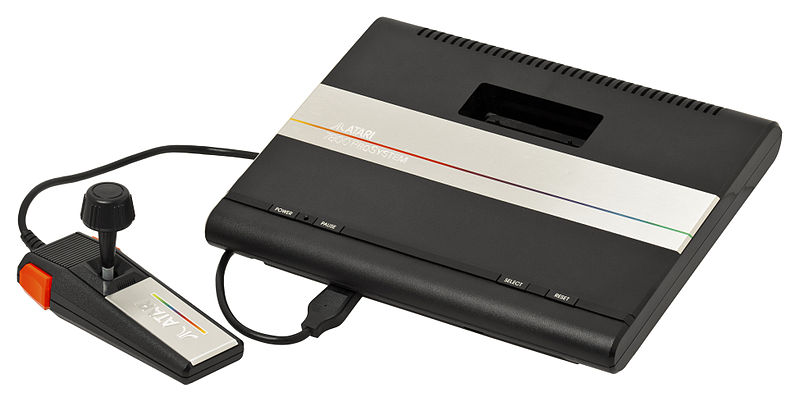
|
The Atari 7800 ProSystem, or simply the Atari 7800, is a video game console officially released by Atari Corporation in January 1986. The 1986 launch is sometimes referred to as a "re-release" or "relaunch" because the Atari 7800 had originally been announced in May 1984, to replace Atari Inc.'s Atari 5200, but a general release was shelved due to the sale of the company. In January 1986, the 7800 was relaunched and would compete that year with the Nintendo Entertainment System and the Sega Master System. It had simple digital joysticks and was almost fully backward-compatible with the Atari 2600, the first console to have backward compatibility without the use of additional modules. It was considered affordable at a price of US$140. |
| The ColecoVision is Coleco Industries' second generation home video game console, which was released in August 1982. The ColecoVision offered near-arcade-quality graphics and gaming style along with the means to expand the system's basic hardware. Released with a catalog of 12 launch titles, with an additional 10 games announced for 1982, approximately 145 titles in total were published as ROM cartridges for the system between 1982 and 1984. | |
|
The Magnavox Odyssey², known in Europe as the Philips Videopac G7000, in Brazil as the Philips Odyssey, in the United States as the Magnavox Odyssey² and the Philips Odyssey², and also by many other names, is a video game console released in 1978. In the early 1970s, Magnavox was an innovator in the home video game industry. They succeeded in bringing the first home video game system to market, the Odyssey, which was quickly followed by a number of later models, each with a few technological improvements (Magnavox Odyssey Series). In 1978, Magnavox, now a subsidiary of North American Philips, released the Odyssey², its new second-generation video game console. | |
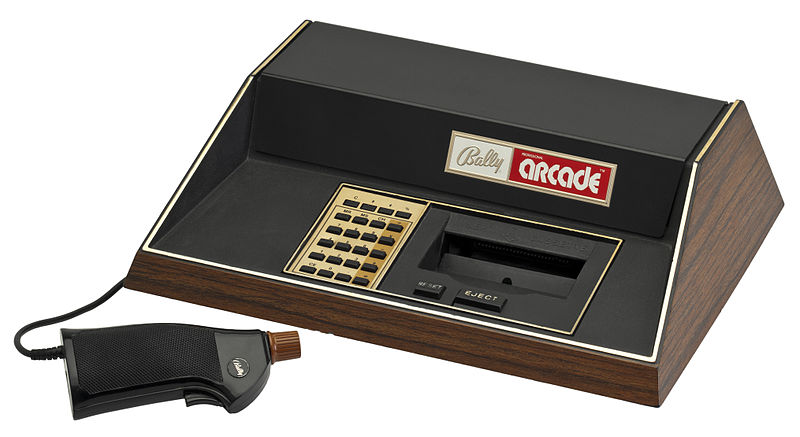
|
The Astrocade is a second generation video game console and simple computer system designed by a team at Midway, the videogame division of Bally. It was marketed only for a limited time before Bally decided to exit the market. The rights were later picked up by a third-party company, who re-released it and sold it until around 1983. The Astrocade is particularly notable for its very powerful graphics capabilities for the time of release, and for the difficulty in accessing those capabilities. |

|
The SG-1000 (エスジー・セン Esujī Sen?), which stands for Sega Game 1000, was a cartridge-based video game console manufactured by Sega. This system marked Sega's first entry into the home video game hardware business, and while the system was not popular, it provided the basis for the more successful Master System. The SG-1000 was first released to the Japanese market on July 15, 1983. Incidentally, this is exactly the same day that Nintendo's Family Computer was released. The console reached minor success in that market and sold moderately well within Asia until 1985. The system was launched in New Zealand as released by Grandstand Leisure Limited, Australia by John Sands and in other countries, such as France, Italy, Spain, and South Africa. The console in its original form was never launched in North America or the UK. |
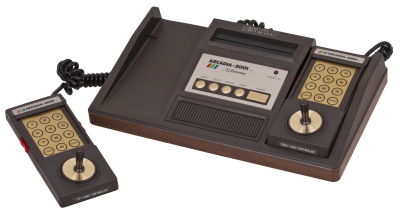
|
The Emerson Arcadia 2001 is a second-generation 8-bit console released by Emerson Radio Corp in 1982 following the release of ColecoVision. It was discontinued only 18 months later, with a total of 35 games having been released. Emerson licensed the Arcadia 2001 to Bandai which released it in Japan, and over 30 Arcadia clones exist. |
 |
The Watara SuperVision (also known as the QuickShot Supervision in the UK) is a monochrome handheld game console, originating from Asia, and introduced in 1992 as a cut-price competitor for Nintendo's Game Boy. It came packaged with a game called Crystball, which is similar to Breakout. One unique feature of the Supervision was that it could be linked up to a television via a link cable. Games played in this way would display in four colors, much like Nintendo's Super Game Boy add-on for the SNES. A full color TV link was also in the works, but because of the Supervision's failure to make a major impression among gamers it was cancelled, along with the games which were in development for it. |
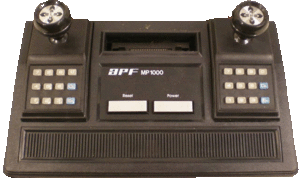
|
The APF-MP1000 is an early 8-bit cartridge-based game console released in 1978 by APF Electronics Inc. The controllers are non-detachable joysticks which also have numeric keypads. The APF-MP1000 can only be used with a color TV and comes built-in with the game Rocket Patrol. The APF-MP1000 is a part of the APF Imagination Machine. It is the successor to the APF TV Fun line of first generation consoles. |

|
The Entec Adventurevision is a self-contained (no external monitor is required) cartridge-based video game console released by Entex Industries in 1982. One particular feature of the Adventure Vision is its "monitor." Rather than using an LCD screen or an external television set like other systems of the time, the Adventure Vision uses a single vertical line of 40 red LEDs combined with a spinning mirror inside the casing. This allows for a screen resolution of 150 × 40 pixels. Another product using this technique was produced by Nintendo in the mid 1990s – the Virtual Boy – another product which, while technically ahead of its time like the Adventure Vision, was doomed to failure in the open market. |
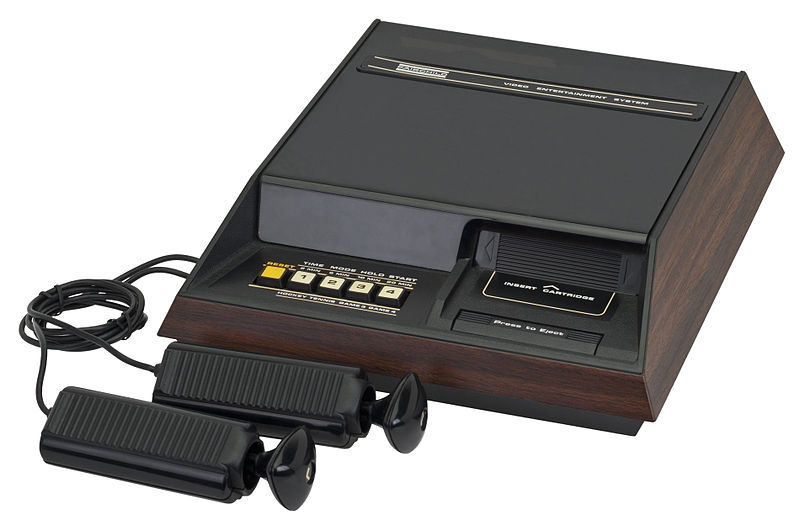
|
The Channel F is a game console released by Fairchild Semiconductor in November 1976 at the retail price of $169.95 (equivalent to $700 in 2014). It has the distinction of being the first programmable ROM cartridge–based video game console, and the first console to use a microprocessor. It was launched as the Video Entertainment System, or VES, but when Atari released their VCS the next year, Fairchild renamed its machine. By 1977, the Fairchild Channel F had sold 250,000 units and trailed behind the VCS. The Channel F electronics were designed by Jerry Lawson using the Fairchild F8 CPU, the first public outing of this processor. The F8 was very complex compared to the typical integrated circuits of the day, and had more inputs and outputs than other contemporary chips. Because chip packaging was not available with enough pins, the F8 was instead fabricated as a pair of chips that had to be used together to form a complete CPU. |

|
The Master System (マスターシステム Masutā Shisutemu?), often called the Sega Master System or SMS, is an 8-bit third-generation video game console that was manufactured by Sega. It was originally released in 1985 as the Sega Mark III in Japan and then redesigned and redesignated the Master System for release in 1986 in North America, 1987 in Europe and Japan, and 1989 in Brazil. The original Master System could play both cartridges and the credit card-sized "Sega Cards," which retailed for cheaper prices than cartridges but had lower storage capacity, while later models removed the card slot. The Master System also featured accessories such as a light gun and 3D glasses which were designed to work with a range of specially coded games. |
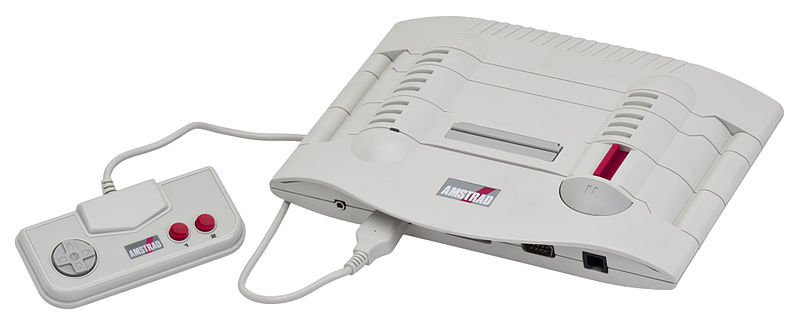
|
The Amstrad GX-4000 is Amstrad's short-lived attempt to enter the games console market. The console was released in Europe in 1990 and was an upgraded design based on the then still-popular CPC technology. The GX4000 shared hardware architecture with Amstrad's CPC Plus computer line, which was released concurrently. This allowed the system to be compatible with the majority of CPC Plus software. The GX4000 was both Amstrad's first and only attempt at entering the console market. Although offering enhanced graphics capabilities, it failed to gain popularity in the market, and was quickly discontinued, selling 15,000 units in total. |

|
The Sega Genesis, also known as Mega Drive (Japanese: メガドライブ Hepburn: Mega Doraibu?) in most regions outside North America, is a 16-bit video game console which was developed and sold by Sega Enterprises, Ltd. The Genesis is Sega's third console and the successor to the Master System. Designed by an R&D team supervised by Masami Ishikawa, the Genesis hardware was adapted from Sega's System 16 arcade board, centered around a Motorola 68000 processor as a primary CPU and a Zilog Z80 as a secondary processor. The system supports a library of over 900 games created both by Sega and a wide array of third-party publishers and delivered on ROM-based cartridges. It can also play the complete library of Master System games when the separately sold Power Base Converter is installed. The Genesis also benefited from numerous peripherals and several network services, as well as multiple first-party and third-party variations of the console that focused on extending its functionality. By the end of 1994, when a new generation of 32-bit consoles rendered the system technologically obsolete, the Genesis had sold 29 million units worldwide, and by the end of its life Sega had sold an estimated 40 million units. |
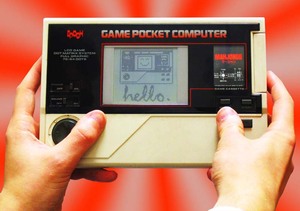
|
The Epoch Game Pocket Computer is a handheld game console released by Epoch in Japan in 1984. It was one of the very few truly handheld systems to be released in the early 1980s, preceding the Game Boy by 5 years. The Game Pocket Computer used an LCD screen with a 75 × 64 resolution, and could produce graphics at about the same level as early Atari 2600 games. The system was a failure in Japan, and as a result, only 5 games were made for it. A puzzle game and a paint program were built into the system. It was powered by 4 AA batteries, and screen's brightness could be adjusted by the user. Possibly due to its failure in Japan, the Game Pocket Computer was never released in North America. The unit is extremely rare, and units on eBay can go for hundreds of dollars, when and if they turn up. |
 |
The Mega Duck WG-108 (also known as Cougar Boy) is a handheld game console that was produced by Hong Kong-based Welback Holdings through its Timlex International division and came on the market in 1993. It was marketed under various different brands worldwide including Creatronic and Videojet. It was sold for about fl 129 in the Netherlands, and for a similar price in France and Germany. In South America (mainly in Brazil), the Chinese-made Creatronic version was distributed by Cougar USA, also known as "Cougar Electronic Organization", and sold as the "Cougar Boy". |
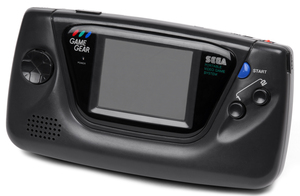
|
The Sega Game Gear (セガゲームギア) is a handheld video game console developed by Sega and released in late 1990 as a response to Nintendo's Game Boy handheld . It is a full colour console and was Sega's first attempt to compete in the handheld games market (the second being the Sega Nomad — a handheld Sega Mega Drive). In South Korea it is known as the Handy Gam*Boy (핸디겜보이). The Sega Game Gear is a "portable" device which was designed to address problems with Nintendo's Game Boy. It is held lengthwise at the sides (preventing the cramping of hands which plagued Nintendo's system) and has a backlit, colour LCD screen, allowing for clearer and more vibrant visuals than its main rival. Similarly to the Sega Mega Drive, which at the time was Sega's main focus in the home console market, the Sega Game Gear is derived from the earlier Sega Master System. Unlike the Mega Drive, however, the Game Gear is largely identical to the Master System, the major difference being a VDP capable of displaying palettes consisting of a wider variety of colors, and the playback of stereo sound. Game Gear games traditionally run at a smaller resolution too, although with a screen built similarily to televisions of the era, the Game Gear is fully capable of playing games in higher resolutions. Game Gears were also manufactured at a time where capacitor problems were rampant across the electronics industry. As a result, screen and audio failures are common, and fixes are not always simple. |

|
The Epoch Super Cassette Vision (カセットビジョン Kasetto Bijon?) was a video game console made by Epoch and released in Japan on July 30, 1981. The console used cartridges and it has the distinction of being the first successful programmable console video game system to be made in Japan. The system retailed for 13,500 yen, with games going for 4,000. It is believed, though not confirmed, that Sega and/or SNK made games for the Cassette Vision. Its graphics were less refined than the Atari 2600, and the only controls were four knobs (two to a player, one for horizontal movement, one for vertical) built into the console itself, along with two fire buttons to a player. Though the Cassette Vision was not a fantastic seller, it managed to spawn off a smaller, cheaper version called the Cassette Vision Jr. and a successor called the Super Cassette Vision. The latter was released in 1984, and was sold in Europe, with little success. Except for their failed Game Pocket Computer handheld system, Epoch never had another system released. |

|
The Bandai Super Vision 8000 is a video game console released by Bandai in 1979 belonging to the second generation. The console can be directly connected to a TV. This console was the last of the Bandai TV Jack console series but was completely different from the other consoles of the series. The Super Vision 8000 had a central CPU. The other consoles belonged to the first generation: they didn't feature a microprocessor, and were based on custom codeless state machine computers consisting of discrete logic circuits comprising each element of the game itself (Pong-style console). |

|
The VTech Socrates is an educational video game console released in 1988 by VTech. The console featured a robot character Socrates, named after the philosopher. The character is visually similar to Johnny Five from the Short Circuit movies. The system featured standard wireless controllers that communicated via infrared reception. In Germany, the system was sold by "Yeno" under the name "Prof. Weiss-Alles". The graphics and sound of the games were noticeably slow, with the system often taking several seconds to complete drawing and color filling a static picture; small areas could move more quickly. There was a very noticeable delay between user input and the system responding. Response times did not seem to be affected by the presence or absence of the voice cartridge. The system was quite expensive upon its initial release; most consoles saw prices of up to $130. Due to the price and the competition with VTech's other products, including the Whiz Kid systems, the Socrates was phased out after only a few years. Today, it is considered rare. |
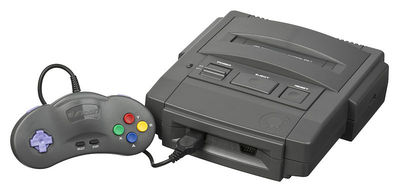
|
The Super A'Can is a console that was released exclusively in Taiwan in 1995 by Funtech. Inside is a Motorola 68000, also used in the Sega Genesis and Neo Geo. Twelve games have been confirmed to exist for the system. The twelve (12) confirmed games, with an additional nine (9) protos rumored to be in existence, were released in rather large, SNES-like cartridges. Games were presented in cardboard boxes featuring flamboyant artwork and included a plastic game holder along with the instruction manual (also well presented). This matched the fun and playful design of the systems packaging. Overall game graphics and play are very similar to the Neo Geo and SNES. Bold, vibrant colors are pleasantly displayed in 2D environments. One of the best games for this system is C.U.G., a Super Mario type clone. The Super A'Can failed miserably due to utilizing outdated technology and being initially offered for sale at an exorbitant price. Very few of these systems were sold and it has been reported that Funtech Entertainment Corporation lost $6 million USD in this venture. Unsold units were disassembled and were parted out to various companies in the USA and abroad. |
3,602
RESULTS
rss
TOPIC atoz
LANGUAGE
eye 1.2M
eye 1.2M
eye 91,117
eye 31,663
eye 17,408
Fetching more results



 Open Library
Open Library








